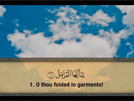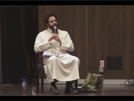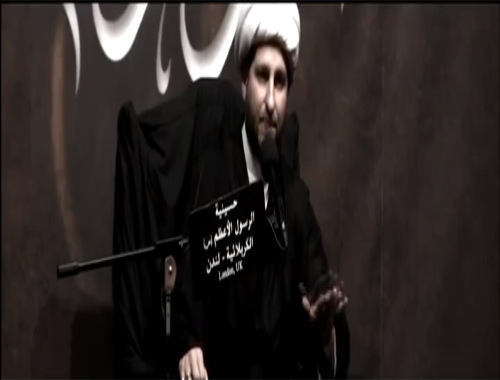Kadhimain Holy Shrine
- Details
- Hits: 3716

Kadhimiya Holy Shrine was and is still a place surrounded by the holy angels, and a good neighbor; loved by scholars and pious people. It is the glorious venue where kings and sultans stand before in reverence; where the sublime honor yields in submission; where wishes are fulfilled by Allah. It is a spot where the Divine Mercy and Blessings descend, by which all hearts are enchanted. Hence, it is worthy of being the heart of Kadhimiya and crown of Baghdad.
It welcomes the visitors, from far and near, who are longing for it, hailing them with its domes that are brighter than the sun and its golden minarets extending high in the sky. It is as if they are calling visitors to the place where wishes are fulfilled and prayers are answered with the will of Allah. It is verily the place where the distressed get relief and where the oppressed resort and then go back to their people in joy…
It is the paradise of Musa Al-Kadhim (A.S) and Mohammed Al-Jawad (A.S)
Preface
Quraish Cemetery, located at the west bank of Baghdad, has, over history, acquired a special honor and unique grandeur, after the burial of the Imam Musa bin Jaafar Al-Kadhim (A.S), and later his grandson Imam Mohammed bin Ali Al-Jawad (A.S). The two holy graves attracted so many hearts for visits, and loyal souls were stimulated to construct a magnificent building for the two holy graves.
The construction of the Holy Shrine of the two Imams (A.S) passed through many stages. At the hands of successive generations, the Holy Shrine has witnessed successive improvements ever since. All the people who wrote on this Holy City, in general, and the Holy Shrine, in particular, reviewed the renovations of the building.
Among those who wrote on this subject was the prominent scholar Sheikh Mohammed Aal-Yaseen in his book (History of the Kadhimi Shrine) which was deemed to be the most valuable legacy that reviewed the history of this holy city and, therefore, was selected as a reference to write these lines.
The building of the Kadhimain Holy Shrine is a magnificent one in which the art of the Islamic architecture and the Muslim genius of creativity and craftsmanship are embodied. Heaps of gold, silver and enamel glisten in every side of it. On the walls and ceilings glitter the tiny mirrors skillfully fitted together to match the other surrounding decorations, speaking for themselves, representing a masterpiece, entirely unequalled in the world of architecture.
Kadhimiya At a Glance
In 145 H. (approx. 762 AD), Al-Mansoor, the Abbasside caliph, started the foundation of the circular city "Baghdad". Construction completed, as narrated by Al-Khateeb Al-Baghdadi, in 146 H, whereas the great wall, the moat that surrounded the city and other requirements were finished in 149 H.
Finishing the construction of the city, Al-Mansoor assigned the area adjacent to his city from the north as a cemetery. Perhaps, he assigned it to be private for his own family, and later, it was called "Quraish Cemetery", and sometimes referred to as "Hashim Clan Cemetery". In his book Al-Irshad, Sheikh Al-Mufeed stated that it was a cemetery owned by Hashim Clan and the notables in general.
The first man buried in that cemetery was Jaafar s/o Al-Mansoor, the Caliph, in 150 H. (approx. 767 AD). Then burials continued in the cemetery.
On 25th Rajab, 183 H. (approx. 31st Aug., 799 AD), Imam Musa Al-Kadhim (A.S) was poisoned to death by Al-Sindi bin Shahik, under orders from Haroon Al-Rashid, the Abbasside caliph. His pure corpse was taken to Quraish Cemetery for burial, and his holy tomb is located at the same place, known afterwards as Kadhimiya.
Some historians mentioned that he was buried in a place that he purchased before, within the said cemetery.
Al-Kadhim's tomb was then famous for the name "Babul-Tibn Tomb", referring to Babul-Tibn district which was located to the east, in the vicinity of the River Tigris. Moreover, the mosque neighboring the tomb was also called "Babul-Tibn Mosque".
At the end of Thul-Qi'da, 220 H. (approx. 25th Nov., 835 AD), Imam Mohammed Al-Jawad (A.S), the grandson of Imam Musa Al-Kadhim (A.S) was murdered and buried next to his grandfather.
The area began to be increasingly inhabited, following the burial of the two Imams. Driven by their strong faith in the two Imams, people began to reside around the tombs, for providing protection, administration and lodging for the coming visitors.
At the beginning of the 10th Century, Kadhimiya entered its new era in terms of internal administrative independence. The city became of a distinguished entity and played its own role in the general affairs. In 914 H. (approx. 1508 AD), Safawis occupied Iraq. Shah Ismael Al-Safawi visited Kadhimiya and gave orders to set up a special administration for the city, and an Islamic court headed by a judge with the title (Sheikh Al-Islam). He also ordered to re-construct the Kadhimi Shrine in a splendid way, and assigned salaries for the officials and servants of the Shrine.
In 1302 H. (approx. 1884 AD), Brag. Hidayat Pasha, commander of the 6th Military Corps of Turkey ordered to install a wooden pontoon bridge across the River Tigris to link Kadhimiya and Aadamiya. In this way, Kadhimiya was linked to the eastern part of Baghdad too. In 1318 H. (approx. 1900 AD), the cornerstone of Kadhimiya Sarai (governmental administration offices) was laid.
Over its long lifetime, Kadhimiya gave birth to a great number of Scholars of Fiqh, writers, poets, intellects, and physicians. The city also had a number of religious schools which offered classes in Islamic sciences. They were full of students and teachers. The most prominent school was Mohsin Al-Aaraji School which was founded at the advent of the 13th Hijri century. The city also had some great libraries, full of references and manuscripts. It was said that the first Iraqi stone press was founded in Kadhimiya in 1237 H. (approx. 1821 AD). This achievement came at the top of the academic activities list of the city in the first part of the thirteenth century.
The British army occupied Kadhimiya on the 17th Jamada Ola, 1335 H. (approx. 11th March, 1917). Hence, a long Ottoman occupation age ended to start with another occupation. Following the British occupation, Kadhimiya did not stop action against the occupiers with all material and moral powers available; a fact which was clear in Miss Bell's letters when she wrote: "There's a group of these worthies in Kadhimain, the holy city, 8 miles from Bagdad, bitterly pan-Islamic, anti-British". Philip Ireland, on the other hand, stated that the anti-British feeling in Kadhimiya was so strong that the religious scholars threatened that all those who vote in favor of the British occupation would be considered apostate.
Conclusion
Today, following the defunct regime which paid no attention to the holy places, including Kadhimain Shrine which was almost entirely neglected and left to deterioration, the Holy Shrine required renovations and maintenance. With the Will of Allah, the loyal believers started projects of construction and development and work undertaken by the Secretary General of the Holy Shrine is still afoot. The said projects amounted to about 100 projects, including but not limited to:
Maintenance and re-gilding the tombs of the two Imams (A.S), replacing the tomb metal structure, expanding the Haram, maintenance of the tomb metal structures of Sheikh Al-Mufeed and Sheikh Al-Toosi, replacing the silver and wooden gates of the porches with golden ones which are nine in number, construction of a new courtyard to the north over an area of 7000 square meters, tiling the ground of the courtyard, tiling gatehouses with twig tiles, maintaining the rooms of the courtyard and upstairs rooms, construction of the gates and entrances of the courtyard, installing new three gates, the project of Sahib-Al-Zaman courtyard to the west, Imam Ali courtyard which is adjacent to the new established courtyard, and the bathrooms project.
These continuous projects aim at the maintenance and development of this Holy Place which is increasingly visited by Muslims from all over the world. So there was a substantial need to make new service and sanitary utilities, in the forefront of which was the expanded courtyard to the north, so that the ever increasing number of visitors would be properly served; since our motto is "To serve visitors is our honor".
Taken from: ALJAWADAIN.ORG











